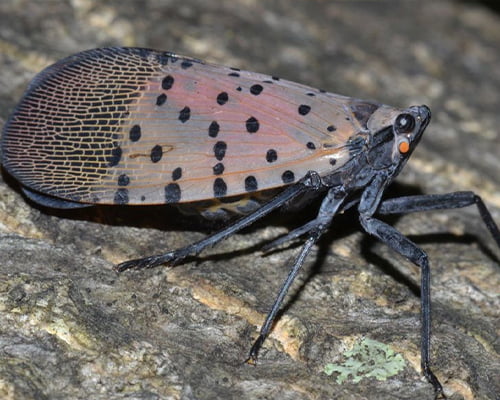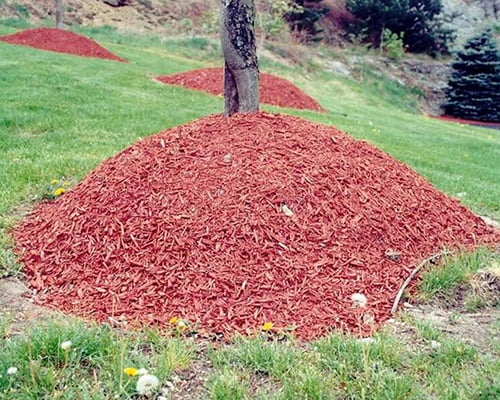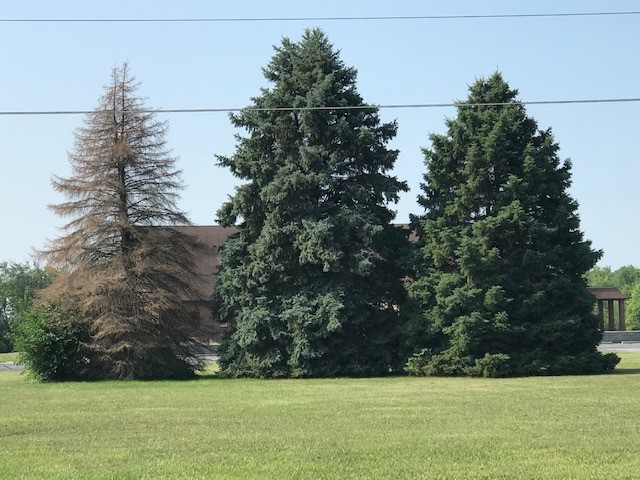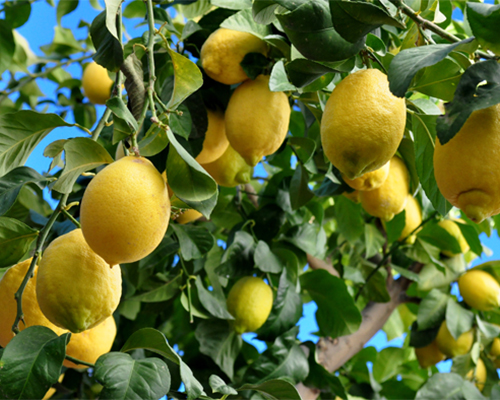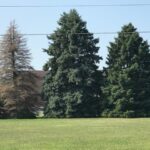
Why your Evergreen is Dying and how to Save It
September 7, 2025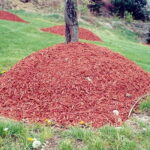
Mulch Saves Lives
September 7, 2025The spotted lanternfly (Lycorma delicatula) was first detected in the United States in Berks County, Pennsylvania in September 2014 (PA DoA 2015). The insect had been present for two years (Spichiger 2015). By January 2018, the Pennsylvania quarantine included portions of 13 counties in the southeastern part of the state (PA DoA 2017).
By October 2018, the spotted lanternfly had been detected in multiple additional Mid-Atlantic states:
- Delaware: One live adult spotted lanternfly was found in New Castle County, Delaware, in the Wilmington area in November 2017. One dead adult spotted lanternfly was found in Dover, Delaware, in October 2018. See: https://news.delaware.gov/2017/11/20/spotted-lanternfly-confirmed-delaware/and https://news.delaware.gov/2018/10/16/spotted-lanternfly-found-last-week-dover-hitchhiker/
- Maryland: One male adult spotted lanternfly was found in a trap in Cecil County, Maryland. https://www.washingtonpost.com/local/spotted-lanternfly-menace-to-crops-confirmed-in-maryland/2018/10/27/80869956-d99f-11e8-83a2-d1c3da28d6b6_story.html
- New Jersey: One or more live nymph spotted lanternflies were found in Warren and Mercer counties, resulting in the quarantine of Warren, Hunterdon, and Mercer County. See: https://whyy.org/articles/new-jersey-issues-quarantine-for-items-carrying-spotted-lanternflies/
- New York: Live adult spotted lanternflies were found in Yates, Albany, and Suffolk Counties in late summer 2018 and fall 2018. See: https://www.news10.com/news/local-news/invasive-lanternfly-insect-spotted-twice-in-upstate-new-york/1436259025 and https://www.newsday.com/long-island/suffolk/spotted-lanternfly-suffolk-county-1.22196507 One dead adult spotted lanternfly was found in Delaware County, New York, in November 2017. See: https://www.agriculture.ny.gov/AD/release.asp?ReleaseID=3637
- Virginia: Multiple live adults and egg cases of spotted lanternfly were confirmed in the town of Winchester Virginia which is in Frederick County, in January 2018. See: https://ext.vt.edu/agriculture/commercial-horticulture/spotted-lanternfly.html It is worth noting Winchester VA and central Pennsylvania (to the West of the quarantine area) are both on Interstate 81. Northern Virginia, including the valley in which Winchester is found, has widespread populations of Ailanthus, the primary host tree of spotted lanternfly. The Winchester region is also a center of fruit orchards and Virginia’s growing wine industry is close by to the East.
In response to the rapid growth of the infested area, on 7 February 2018 the USDA announced that it had allocated $17.5 million in emergency funds to stop the spread of spotted lanternfly. The funds are from the Commodity Credit Corporation – a transfer authorized by 7 U.S.C. 7772 (Title 7: Agriculture, Chapter 104: Plant Protection, Subchapter IV: Authorization of Appropriations). The new funds will allow APHIS to expand its efforts to manage the outer perimeter of the infestation while the Pennsylvania Department of Agriculture will focus on a 3-mile perimeter surrounding the core infested area. The goal of this expanded surveillance and control program is to stop the leading edge of the infestation and start pushing it inward while at the same time reducing the density of spotted lanternfly populations in the core-infested area. APHIS will use existing resources to conduct surveys, and control measures if necessary, in Delaware, Maryland, New Jersey, New York and Virginia (USDA Press Release No. 0031.18).
Upon discovering the insect in 2014, Pennsylvania began an intensive survey to delimit the outbreak and instituted a quarantine to prevent spread of the insect. The quarantine applied to movement of all known or suspected vectors, including brush, debris, bark, or yard waste; logs, stumps, or any tree parts; firewood of any species; grapevines; nursery stock; and crates; landscaping, remodeling or construction waste; and such outdoor household articles as recreational vehicles, lawn tractors and mowers, mower decks, grills, grill and furniture covers, tarps, mobile homes, tile, stone, deck boards, mobile fire pits, any associated equipment and trucks or vehicles not stored indoors (PA DoA 2015).
The spotted lanternfly is a planthopper from Asia, found in countries ranging from China, Korea, and Vietnam to India. It has been introduced to Korea (in 2004), and possibly other countries. In Korea, the lanternfly utilizes 67 plant species, including many important agricultural crops, such as wild and cultivated grapes, stone fruits (plums, cherries, peaches, nectarines, apricots, almonds), apples, willow, and various hardwoods, and even pines. [Pennsylvania Department of Agriculture alert; APHIS alert]
The plants are damaged by both the loss of sap from stems and leaves – which reduces photosynthesis; and deposition of large amounts of fluid (honeydew) – which promotes mold growth [APHIS alert].
Lanternflies lay egg masses on smooth bark, including on willow, maple, poplar, sycamore, and such fruit trees as plum, cherry, and peach. [APHIS alert] Lanternflies also lay eggs on brick, stone, and other vertical surfaces. Possible egg sites include vehicles, campers, yard furniture, farm equipment or other items stored outside, or even masonry walls (PA DoA 2015).
Nymphs develop through four immature stages. During this development, they spread from the hatching site by crawling (PA DoA 2015). The first three instars have been found on 30 species in Pennsylvania, including oak, birch, blackgum, and poison ivy. Third instars seek tree of heaven (Ailanthus altissima) – an introduced and invasive tree that is widespread in the Mid-Atlantic region (as well as elsewhere in North America). Immature instars crawl up the trunk early in the day, then back down in the afternoon or evening, so sticky bands can effectively trap the insect (Spichiger 2015). Fourth instar nymphs are very active (unlike adults or earlier instars); they hop and fly several feet (Rhodes 2015). Adults appear as early as July (see photo). Adults are poor flyers, but strong jumpers (PA DoA 2015).
In the fall, adults seek tree of heaven (Ailanthus) as the preferred site for egg laying. However, as noted above, lanternflies will use a wide range of smooth vertical surfaces (PA DoA 2015).
Infested trees can have weeping wounds of sap on the trunks. As insect populations rise, honey dew secretions build up at the base of the tree, blackening the soil around the base. The largest colonies can produce large fungal mats at the base of tree. Wasps, hornets, bees, and ants attracted to the honeydew secretions can become conspicuous (PA DoA 2015).
Pennsylvania also asked the public to help by scraping egg masses off trees or other surfaces and collecting or photographing specimens for the survey effort (PA DoA 2015). Total number of eggs recorded as scraped and killed as of 1/10/2018 was 1,689,660 (PA DoA 2018). They have also trapped over one million nymphs on tree bands (PA DoA 2018).

